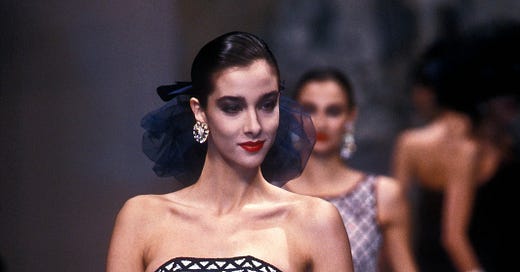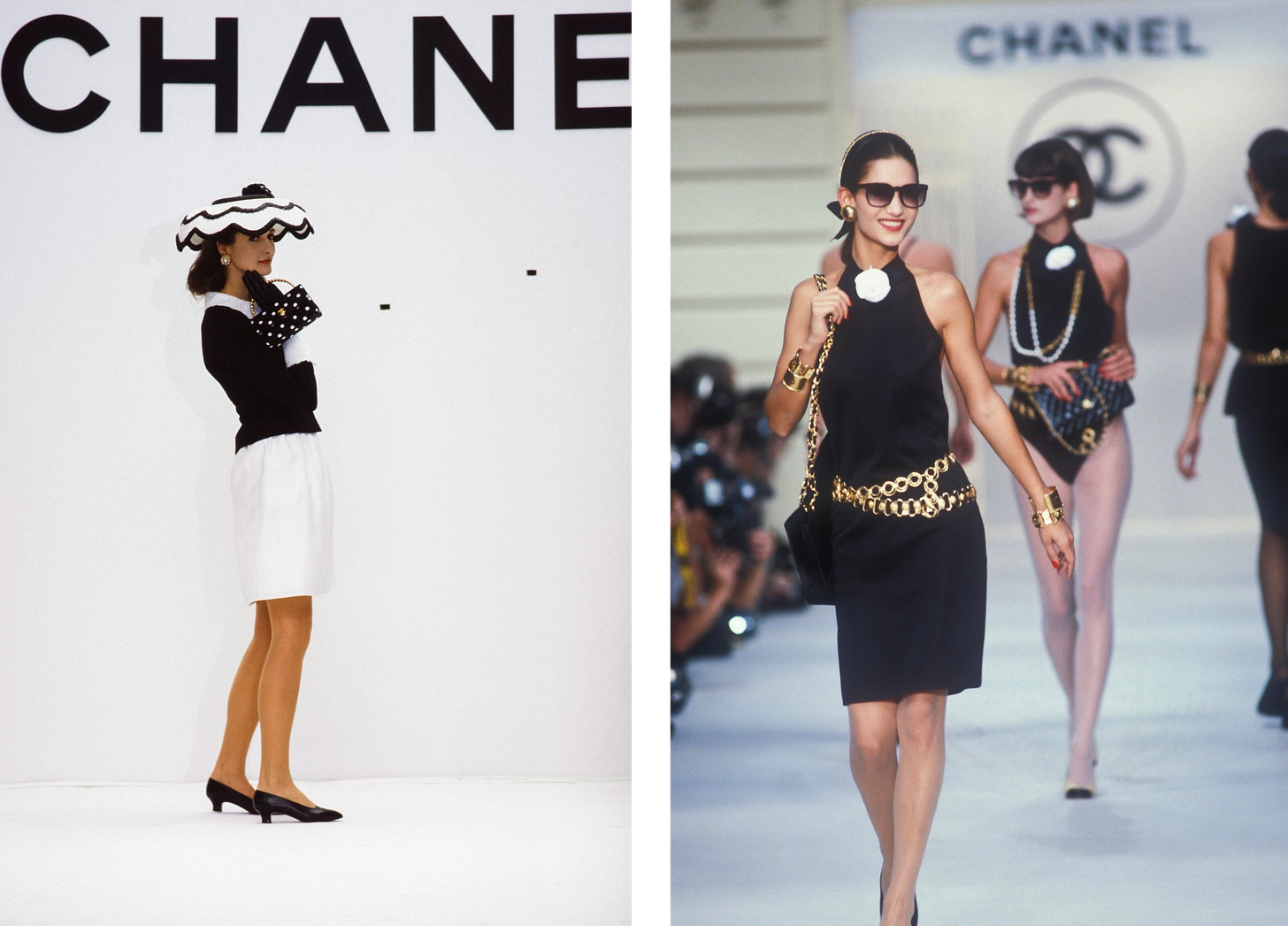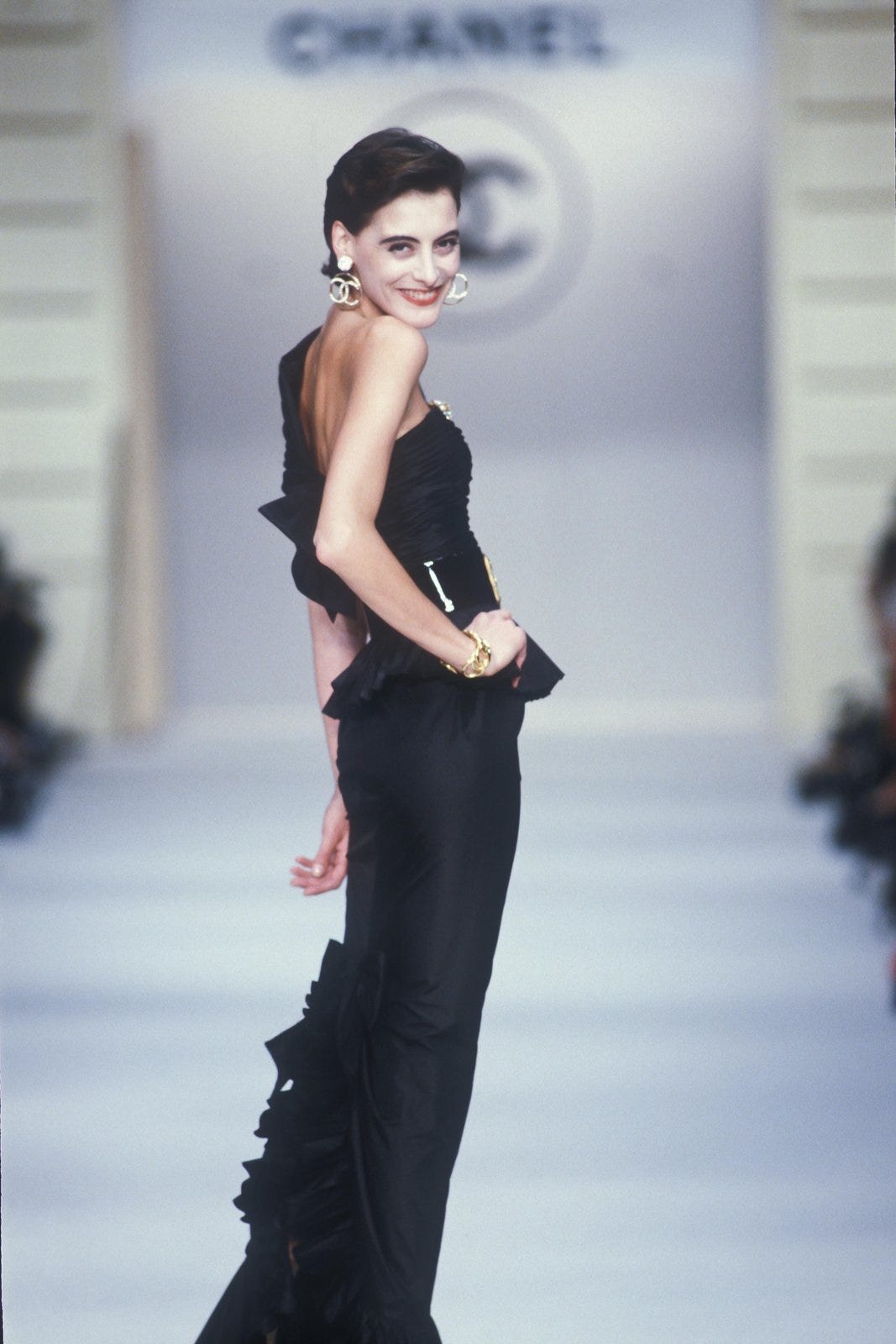10: Unfolded: The 1980s, Chanel, and the Allure of a Logo
How the cultural and economic shifts of the 1980s transformed our relationship with the luxury logo
This essay is part of an ongoing series on The Pleat called Unfolded. Unfolded is a monthly historical essay on a topic of my choosing that touches on the intersection of consumerism, environmentalism, and fashion history.
Chanel was the first designer brand I knew – maybe because my Mom wore Chance or maybe because Coco Chanel was the first result when I naively Googled “most famous fashion designers in history”. I had just discovered the world of fashion blogs, just joined Instagram, and was spending most of my free time on the now-defunct Polyvore collaging outfits together.
The interlocked Chanel Cs quickly transformed to represent all that I thought I wanted. They were the logo of 1980s decadence, of elderly Upper Eastsiders, of washed-out Instagram flat lays, WeHeartIt phone backgrounds, and never-opened coffee table books. They went with Diptyque candles, Laduree macarons, pink peonies, bubble baths, Breakfast at Tiffany’s, and Vogue. The logo became a symbol of my Metropolitan-City magazine editor Blair Walford-esque fantasy. Of course, in retrospect, my interest in Chanel had nothing to do with the clothes and everything to do with the logo.
The extraordinary triumph of luxury is its ability to symbolize something grander than the handbag or the coat. Some of us spend our whole lives dreaming of designer items, for years I wanted a Chanel flap bag – not because I liked black leather quilting but because the interlocked Cs became a symbol for the life I thought I wanted. For many of us, the luxury brand, and the logo, become symbols of status, of wealth, of taste, or of success.
The 1980s permanently transformed our relationship with luxury. Within three years of Coco Chanel's death in 1971, the Chanel name was increasingly becoming associated with its aging clientele and outdated fashion line – the Maison desperately needed new leadership. Alain Wertheimer became Chanel’s chairman in 1974 and in 1979, Wertheimer brought in Kitty D’Alessio, a senior Vice President and Board Member at the advertising firm N.C.& K to take charge of the Chanel operation in the United States.1 In 1981, D’Alessio made a pivotal decision to hire Karl Lagerfeld as the Creative Director of Chanel, despite his existing contract at Chloe that forbade him from designing ready-to-wear under the name of another house.2 After years of convincing, Lagerfeld's first couture collection for Chanel debuted in early 1983, followed by his ready-to-wear collection in the spring of 1984 after his last at Chloe. Almost immediately, Lagerfeld adorned everything in the double CC logo but it was not just the logo that he employed, he gave new life to all of Coco Chanel’s design notes – two-tone heels, leather quilting, tweed suits, gold and leather chained accessories and pearl buttons. Of course, it is Lagerfeld whom we credit with saving Chanel but the cultural and economic landscape of the late 1980s allowed their vision to soar. The Chanel renaissance was enabled by the evolving relationship between advertising, magazines, lifestyle, and the growing significance of status symbols against the backdrop of the economic uncertainty of the 1980s.
When Kitty D’Alessio took the job at Chanel, the United States was on the precipice of a decade of vast economic and cultural change. Her hiring could not have been more opportune. The 1980s in the United States were defined by Reagan-era laissez-faire economic policies, conservative tax reform, rising unemployment, and profound cuts to social services. Amid the vast economic uncertainty for millions across the country, the rich "were encouraged to spend with abandon," and "the very act of purchase became a symbol of success."3 It was within this context that Chanel was able to prosper and within this context that the interlocked Cs became an enduring symbol of luxury, status, and fashionable fantasies.
In 1980, over half of all women in the United States, 44.7 million, were in the paid workforce. Not only was there record-breaking participation, there was a notable increase in the number of women working in professional fields. From 1970 to 1980, the number of female lawyers surged by 188 percent, and female physicians increased by 44 percent.4 Among the women in the workforce, 60% were married, which meant a record number of families had dual incomes and disposable income for the first time.
The increase in women in the workforce paralleled an effort in the advertising industry to carve out niche markets to appeal to narrower groups of consumers. After the 1960s, the post-war advertising strategy that sought to capture a unified American audience became increasingly ineffective. Rather than perceiving this as a failure, the industry seized the opportunity to transform a fragmented audience into distinct markets. Sarah Banet-Weiser explains, “…the emphasis on the power of visibility provides a crucial point for advertisers and marketers, who capitalized on these struggles, for working them into marketing to create specific niches that directly appealed to narrower groups of consumers based on identity, culture and lifestyle.”5 This approach led to the rapid formation of markets, notably along the lines of age, gender, race, lifestyle, and occupation. Lifestyle became of particular interest to the advertising industry, the idea of “upscale” became a vague term to not only target an affluent audience but to market an aspirational lifestyle to everyone else. Similarly, as the material conditions of women's lives changed and their roles in the workforce evolved, magazines responded.
There were magazines for teens, Young Miss, ‘Teen and Seventeen. Magazines for women 18-34, Mademoiselle, Glamour, Self and Cosmopolitan. Magazines for women slightly older and slightly wealthier, Bazaar and Vogue. There were magazines for women who worked, Working Woman, Working Mother, New Woman, Savvy, Newsweek Woman. Magazines for those who didn’t: Family Circle, Woman's Day, Good Housekeeping, Ladies' Home Journal, McCall's, Better Homes, and Garden. And magazines for women of color: Essence, Latina, Buenhogar, Cosmopolitan en espanol, Vanidades Continental, Claudia, Tu.6 The proliferation of women's magazines reflects the segmentation of women along various lines of identity.
Unlike on social media, in a magazine, the advertisements are just as crucial to the experience of reading Vogue as the content itself. Sometimes we want to see the new Prada campaign more than we care to read the cover story at all. In September of 1981, Vogue published “the biggest magazine ever published in America”. At a record-breaking 614 pages, 435 of them were advertisements.7 The relationship between the magazine and the advertiser is reciprocal – the magazine wants to retain the quality of the publication and the advertiser wants to reach a certain audience. The magazines were not only in the business of writing articles but they were in the business of teaching the reader how to consume for the lifestyle they desired.
In Decoding Women’s Magazines, Ellen McCracken explains the key to the success of magazines is their ability to “make the dream near at hand at the same time the fantasy alluring beyond one's reach.” In the 1980s, Bazaar’s average household income was $27,379 – 61% of them with household incomes at or above $25,000 and 39% below.8 It is unlikely that most of the Bazaar’s readers were splurging on the several thousand dollar dresses featured in the magazines' pages but for a moment, they could flip through the pages and dream. The spread featuring a several thousand dollar designer dress might’ve been followed by a cosmetic advertisement bearing the same designer's name.
The desire for fashion status symbols that magazines and advertisers manufactured in the 1980s led to the proliferation of the small luxury goods market. Designers stepped into the perfume game en masse and many of them created diffusion lines. When Alain Wertheimer assumed the role of Chanel’s chairman in 1974, the only remaining asset was Chanel No. 5 and the Maison was on the brink of bankruptcy.9 He quickly introduced a cosmetic line and later, in 1977, a ready-to-wear line. Throughout the 1980s, Chanel’s cosmetics and skincare line rapidly expanded. The success of Chanel’s renaissance can largely be credited to the sale of their most inexpensive items – perfumes, cosmetics, skincare, accessories and their t-shirts.10 Of Chanel’s $80 t-shirt, in April of 1987, The New York Times reported that “stylish women are showing everywhere in Chanel shirts, which come in black and white, with the familiar 5’s of varying sizes emblazoned on the front.”11 While the $5,000 Chanel dress is surely out of reach for most, a bottle of perfume, lipstick or a t-shirt with the same logo probably isn’t. For a fraction of the price, we can experience the feeling of owning a piece of a brand featured in Vogue or Bazaar. By the time Lagerfeld passed away in 2019, Chanel had gone from the brink of bankruptcy to reporting an annual $12 billion in sales.
Chanel’s triumphant revitalization was intertwined with the complex relationship between advertising, luxury, and status symbols that emerged within the economic transformations in the 1980s. As fashion historian Rebecca Arnold aptly explains, “The conservatism and traditional symbolism of many of the objects purchased served to validate the insecure foundations upon which many of the status claims were built.”12 Chanel was not only a defining brand of the decade but in many ways the notion of luxury that Karl presented became symbolic of the new vision of lifestyle in the 1980s. The 1980s were a critical decade in establishing the logo as an indicator of socioeconomic status – but the interlocking Cs of Chanel, the FF logo at Fendi, and the Christian Dior monogram are only meaningful because we’ve given them meaning.
Our sartorial choices are not only a reflection of who we are, and who we want to be but of the societal and cultural context that grounds our choices in history. Whether or not we are finding our meaning in avant-garde anti-fashion, so called “quiet” luxury, “sustainable and ethical”, small designers, vintage clothes, “archival runway” or luxury – what we seek to portray is more or less the same. We are all trying, for better or worse, to negotiate and renegotiate our identities and senses of belonging against the backdrop of everyone else.
Regardless of whether or not we choose the luxury logo to convey the message we want, there is still a profound aura of desire around the luxury market. Perhaps the “insecure foundations” are the same and in an era where we are constantly on display, the logo as a universal indicator of success feels like a solution to our uncertainties. Last year, Chanel reported remarkable annual sales of $17 billion, an increase of $5 billion over three years. While some of this growth can be attributed to the Maison’s price increases it also underscores the enduring significance of the symbolism of luxury.
Michael Gross, “Chanel Today,” The New York Times, July 28, 1985, A47.
Gross, “Chanel Today,” A47.
Rebecca Arnold, Fashion, Desire and Anxiety: Image and Morality in the 20th Century, (New Brunswick, NJ: Rutgers University Press, 2001), 9.
Joseph Turow, Breaking Up America: Advertisers and the New Media World, (Chicago: University of Chicago Press, 1997), 61.
Sarah Banet-Weiser, Authentic TM: The Politics of Ambivalence in a Brand Culture, (New York: New York University Press, 2012), 33.
Ellen McCracken, Decoding Women’s Magazines: From Mademoiselle to Ms. (London: Macmillan, 1993), 20.
Philip H. Doughterty, “Advertising; ‘Life Style’ Magazines Prospering'“, The New York Times, November 17, 1981, D30.
McCracken, Decoding Women’s Magazines, 163.
Gross, “Chanel Today,” A47.
Arnold, Fashion, Desire and Anxiety, 10.
“Street Fashion; In Basic Black and White, Chanel to a T”, The New York Times, April 5, 1987, A56.
Arnold, 8.










